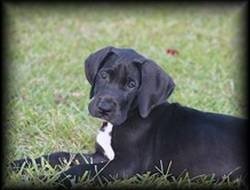
|

|
|
|
| ||
Base Color - Primary Coat ColorFirst, we'll look at the different loci that affect coat color in the Great Dane. In each series, the possible alleles will be listed in terms of dominance, with the more dominant genes at the top, ranging to the most recessive at the bottom. The usual convention is to have the dominant gene capitalized, with recessive genes in lower case letters. To begin, we'll touch on three series, the A-series, the E-series and the D-series. While all three do affect coat color in Great Danes, my intention here is to discuss primarily the Black, Harlequin, Mantle, Merle and White colors. All of these colors are AA, EE, and DD. A-series: This determines the "base" color of the coat. Dogs have two forms of melanin in their coats. One, eumelanin, is dark. It varies in color due to variations in the protein that forms the framework of the pigment granule. The base form of eumelanin is black. Eumelanin can also be brown (also called chocolate or liver) or blue-gray. The other pigment, phaeomelanin, ranges from pale cream through shades of yellow, tan and red to mahogany. The available alleles are:
E-series: The E-series is poorly understood and very controversial. In the simplest form, E=can produce eumelanin, and e=only phaeomelanin is produced (regardless of the A-series genes, and ee dog will show ONLY the yellow/red pigment, as is seen in yellow Labradors and Irish Setters.) There are some theories that Masking (as on our Fawns) and "Brindling" are also on the E-series. Other research indicates that one or both of these traits are at a different locus altogether. In any case, all Great Danes can produce black pigment. For now, I'm assuming (only further research will allow us to know for sure) that "Brindling" is on separate locus, that I'll call Br=Brindle, br=not-brindle. What is clear is that Brindle is dominant to Not-Brindle. D-series: This determines whether the recessive gene that makes the eumelanin Blue instead of Black is present. There are only two alleles.
Other loci that affect coat color in dogs, but do not enter into discussion of the Great Dane are:
So, the Black, Harlequin, Merle, Mantle, and White Great Danes are ALL AAEEDDCCggttBB. To simplify discussion, we will ignore these genes in the rest of our discussion, as all loci are homozygous for a particular gene, these alleles will not vary from individual to individual. Table of Contents |  Click Here to Vote for My Site! Click Here to Vote for My Site!
Resources: Great Dane Rescue | |
| | ||
Base Color Primary Coat Color Beginning Welcome to the World of the Great Dane.This website strives to bring you the latest information on Great Danes. The content is updated often so make sure and bookmark this site so you can keep up to date on the information. Link To UsReturn to top The Content of this Website is intended as General Information and is NOT Professional Advice. | ||
| | ||



